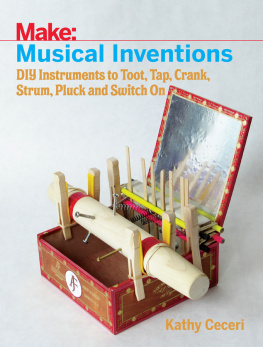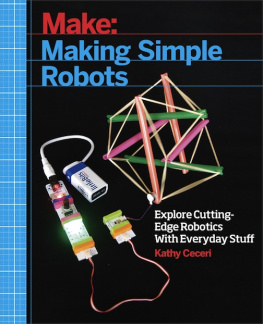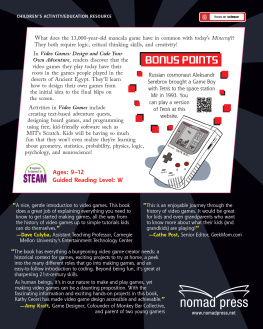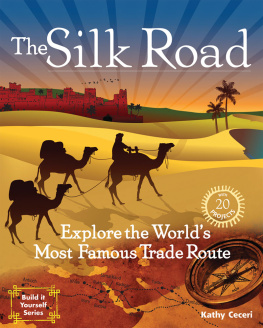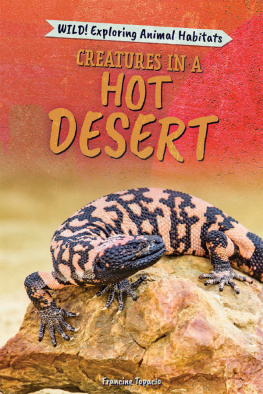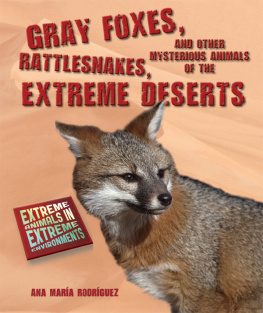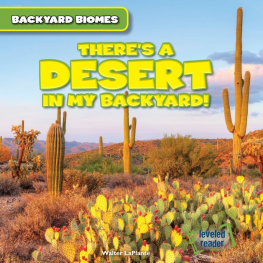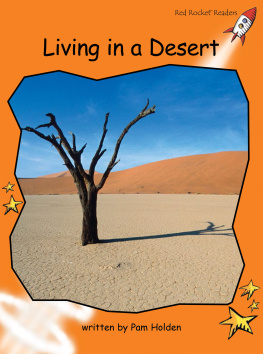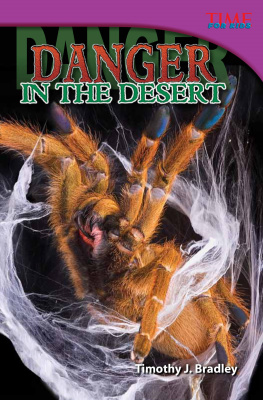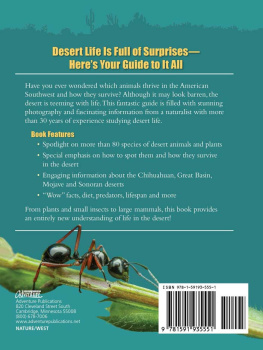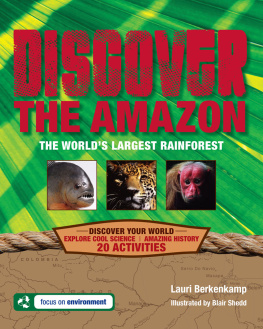
Nomad Press
A division of Nomad Communications
10 9 8 7 6 5 4 3 2 1
Copyright 2009 by Nomad Press
All rights reserved.
No part of this book may be reproduced in any form without permission in writing from the publisher, except by a reviewer who may quote brief passages in a review.
The trademark Nomad Press and the Nomad Press logo are trademarks of Nomad Communications, Inc.
This book was manufactured by Transcontinental, Gagn Louiseville Qubec, Canada
October 2009, Job #36495
ISBN: 978-1-9346704-6-0
Illustrations by Samuel Carbaugh
Questions regarding the ordering of this book should be addressed to
Independent Publishers Group
814 N. Franklin St.
Chicago, IL 60610
www.ipgbook.com
Nomad Press
2456 Christian St.
White River Junction, VT 05001

Nomad Press is committed to preserving ancient forests and natural resources. We elected to print Discover the Desert: The Driest Place on Earth on 4,315 lb. of Rolland Enviro100 Print instead of virgin fibres paper. This reduces an ecological footprint of:
Tree(s): 37
Solid waste: 1,057kg
Water: 100,004L
Suspended particles in the water: 6.7kg
Air emissions: 2,321kg
Natural gas: 151m3
Its the equivalent of:
Tree(s): 0.8 American football field(s)
Water: a shower of 4.6 day(s)
Air emissions: emissions of 0.5 car(s) per year
Nomad Press made this paper choice because our printer, Transcontinental, is a member of Green Press Initiative, a nonprofit program dedicated to supporting authors, publishers, and suppliers in their efforts to reduce their use of fiber obtained from endangered forests.
For more information, visit www.greenpressinitiative.org




OTHER TITLES IN THE DISCOVER YOUR WORLD SERIES

CONTENTS

The Driest place on Earth
What is a Desert?
Planning Your desert Expedition
Getting Around in the desert
Water, the Most important Resource
Clothing, shelter, and Food
Desert Dangers and How to Avoid Them
Erg Desert Formation in Algeria

Image courtesy of the Image Science & Analysis Laboratory, NASA Johnson Space Center
INTRODUCTION
The Driest Place on Earth
A t first glance, the desert looks vast, bleak, and empty. The sun beats down, baking the ground until its dry and parched. Dust and sand blow in your eyes, hair, and clothes. The few trees and plants provide little shade. There are no buildings, no roads. If any animals are around, they must be hiding underground. Why on Earth would you want to visit such a place?
Because theres a lot more to the desert than heat, sun, and sand. In fact, its a world of unique sights and experiences waiting to be discovered.

The desert offers dramatic landscapes filled with enormous sand dunes, twisting canyons, and lonely outcroppings of weathered stone. Its also home to many sacred sites of ancient civilizations. And the hidden riches in the desert are more than just legend. A third of the worlds diamonds and gold can be found here, and half of the worlds oil!
The desert draws teams of scientists looking for fossils, meteors, and lost civilizations. Biologists come to study some of the worlds most unusual plants and animals. And athletes and adventurers travel there for thrilling sports like river rafting and sand boarding.
Ready to start your desert journey? Great! This book is full of fun facts and useful information that will help you find your way around deserts all over the world. Heres a taste of what youll discover in the chapters ahead:

- What Is a Desert? talks about the different types of deserts (theyre not all hot!), where theyre located, how theyre formed, and why theyre important to the rest of the planet.
- Planning Your Desert Expedition reveals some of the unique plants and animals that live in the desert, as well as natural formations and man-made landmarks.
- Getting Around in the Desert covers various ways to travel, from the most ancient to the most modern.
- The next chapters provide information on how to stay safe and healthy in the deserts harsh environment. Water, the Most Important Resource is a look at how desert-dwellers find water in some of the driest regions on the planet. But Clothing, Shelter, and Food are also vital to desert survival. Here youll learn about old and new techniques for remaining comfortable in conditions that can range from mildly unpleasant to extreme.
- Even the best-equipped travelers need to be aware of Desert Dangers and How to Avoid Them. Learn how to find your way and how to deal with threats, both natural and man-made.
- And though the desert is rough, its very fragile too. Well conclude by looking at why we must treat the desert with respect if we want to keep the planet in balance.
To make your journey even more exciting, throughout this book youll see invitations to Try This. These are ideas for science, history, and art projects designed to teach you more about the desert and even make you feel like youre there (even if youre not!). Be sure to check out the resources at the back of the book for ways to learn more. But now its time to turn the page and begin to Discover the Desert

NOTE
Some of the activities need a hot, sunny spot. If its not hot and sunny where you are, try using a desk lamp with a warm light bulb to provide the needed heat and light. Be careful not to get the light bulb close enough to start a fire and make sure you have adult supervision.




